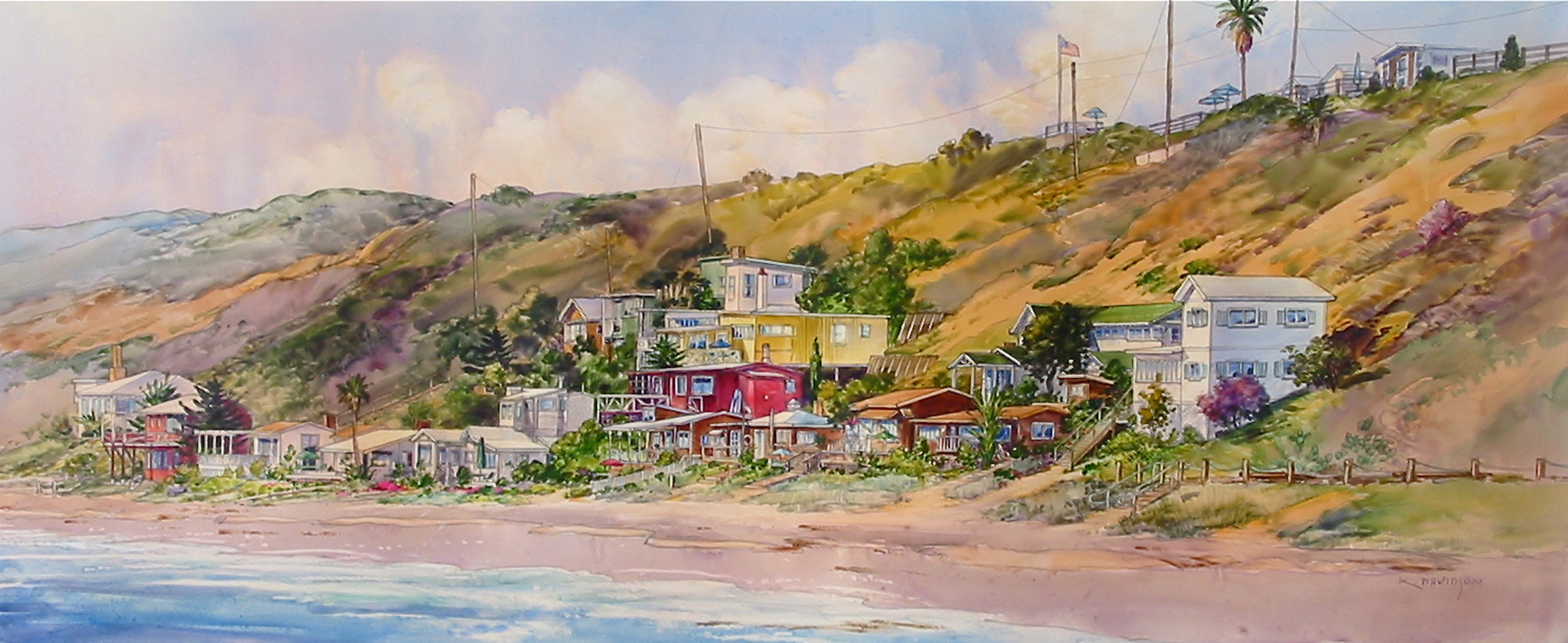How to Properly Hang Art
 With the Laguna Beach Festival of the Arts in full swing, people are feeling inspired to buy art, replace existing pieces or finally find that perfect piece they’ve been searching for to fill the blank spot on their wall. Summer is also a time when many people purchase art during their vacations and travels.
With the Laguna Beach Festival of the Arts in full swing, people are feeling inspired to buy art, replace existing pieces or finally find that perfect piece they’ve been searching for to fill the blank spot on their wall. Summer is also a time when many people purchase art during their vacations and travels.
Buying art is one thing, but displaying it securely in the proper place is another: especially, if you have very large pieces or want something hung on a high, hard to reach spot.
Jay Alderson is the founder and owner of Hangers Art Installation, the premier art hanging business in Orange County. Over the last 10 years he has hung more than 60,000 pieces. He provides highly individualized services for his clients which includes hanging, pick-up and delivery of art, and expert advice on placement of art in your home.
Q: Why would someone need to hire a professional to hang their art?
A: Whether you have paintings, mirrors, or fixtures for either inside or outside your home or office, a professional has all of the necessary tools and experience to make sure that every job is done properly. We provide all of the wall cleats, hangers, and/or security locks as needed. Proper handling is essential for the care and safety of these items and their surroundings.
Q: Do you provide other services besides hanging art?
A: I’ve had 24 years of experience in interior decorating and staging model homes before starting my own business. With my experience and background, I can help clients choose the right locations, heights and environments in which to hang their art and mirrors. We can also hang art and objects on elevated walls, over staircases, or exterior decorative pieces out by your pool, as well as install kitchen pot racks, mirrors, wall sconces and many other items.
Q: Should people buy art they enjoy to fit into spaces, or review spaces first and figure out where art would work well?
A: First and foremost, purchase art you enjoy, but be aware of the space you have available. Don’t buy a 24 by 24-foot piece to go over your eight-foot sofa and don’t buy an eight-foot piece to go over a six-foot sofa. You want there to be balance. For big spaces, multiple pieces work great if you don’t have one large piece of art.
Q: If someone wants to hang framed art or photographs themselves, what do they need to know to make sure it is done correctly?
A: The first thing is to make sure you have two people – one to hold a piece up and the other who can see what changes need to made. Hanging butcher paper in the spot where you think you want a painting doesn’t give you the full picture, as it doesn’t account for the contrast of the frame and colors of the painting. If you are alone, you can use blue masking tape to make the outline of the frame. Use a level and try to avoid hanging picture by wire. Use two D rings and two hooks to keep the picture secure and level. You want to have all the things you hang secured at two points. You also need to make sure the picture hooks are perfectly level on the wall so your picture hangs straight across.
 Q: How do you make sure that what you are hanging is earthquake proof?
Q: How do you make sure that what you are hanging is earthquake proof?
A: There is no such thing as earthquake proof. If an earthquake is strong enough everything is coming down, including the walls. But there are some precautions people can take to ensure their artwork, mirrors and fixtures are as secure as possible. I don’t hang anything from wire. One nail with wire and if there is any shaking at all, the picture slides on the wire and falls off which not only can ruin a piece of art but can seriously injure someone.
Q: If you don’t use wire and nails, what do you recommend people use to hang art?
A: As I said, two D rings and two hooks are best. That keeps the art work stabilized. If you are installing something very heavy – for a hundred pounds or more, you need to use a Z-bar.
Q: What are other places one can display art besides the obvious spots on a wall?
A: Many people now have their TV over their fireplaces, where paintings or photographs used to be. Art can be installed in such a way that it covers the TV yet is easily removed and replaced. That way a beautiful piece of art can finish off the look of the mantel area when guests are over.
Q: Should all of the frames in a room match and can you have too many frames in one space?
A: There is not a one size fits all policy that applies to the “art” of hanging art. It changes. Every drape, color on the wall, or trim, can dictate what you will do with your pictures. Sometimes, a piece of art will require reframing or re-matting after a room has been redecorated. If there are two pictures side by side, the rule of thumb is that they should have matching frames. But if there are many pictures in a room, the frames can be different. Art enhances a room, but there should also be some open space as well.
Q: How do we mix and match different types of art to still blend together?
A: Every space is different. For someone with eclectic taste, they don’t have to stick to one type of art. Try different things to get the look you want. Take risks and have fun … it’s your house. Don’t be afraid to throw out conventional wisdom or rules. There really is no standard, just imaginary guidelines. People see something in a catalog over and over, so they think that is what you’re supposed to do.
Q: Any interesting out of the box things you have hung recently?
A: I have been seeing a lot of old architectural pieces used as artwork. We hung an old canoe that was broken in half from the ceiling outside of a 5,000-square-foot log cabin in Denver. We’ve hung an old VW bug door that someone bought at a gallery on their wall. I also hang a lot of professionally shadow box-framed sports memorabilia.
Q: What works well outdoors?
A: For outdoors, I’d suggest you stick more with metal as a material. You don’t want wood frames near the beach. In two years, the frames will be gone. Some type of iron or metal is best. One of our clients found 25 different types of coat hooks that she wanted to use for towels by the pool. They entertain a lot and have their kids’ friends over to swim so there are always a lot of towels. It was fun for her to search for different types of coat hooks and then we laid out patterns and installed them.
Q: Is it better to fill a big blank spot with something temporary or leave it blank and wait for just the right piece?
A: I have found it is best to wait and get what you want. Otherwise you will never do it and live with something every day that isn’t what you were hoping for. If you aren’t ready to fill a space and don’t have something you love, don’t do it.
Q: I know you don’t install lighting, but how important is proper lighting when displaying art?
A: It’s very important. You can hire a professional to design lighting that will best enhance your artwork. The bigger issue is you don’t want direct sunlight on any artwork because it will destroy it. Make sure you know where the sun comes into a room directly and at what time of day. Also, you can get window shades and coverings that have UV protection.
Q: Is there a great way to display your kids’ artwork?
A: Frames are made now where it looks like a regular frame, but the back is a plastic sleeve and you just take artwork in and out of it so you can change things as often as you like. Also, we have installed wires along walls with clips that make changing what is displayed very easy. Younger kids tend to tug on these a bit more, so either hang the wire out of their reach, or wait until your children grow a bit older.
To reach Jay Alderson, call 949.388.8278 or 949.842.2145, or email him at jay@arthangers.com. Visit www.arthangers.com.



